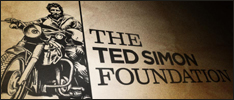Santa Rosa was not a place to linger and we were up early and away with a quick farewell to the dour faced staff at the grotty hotel. It was a grey dawn and the first part of today’s short ride took us through mile after mile of banana plantations. We were off back into the mountains to the city of Cuenca, billed as the prettiest in all Ecuador. It turned into another stunning road looping through red clayed jungle reminiscent of French Guyana. The road was in pretty poor condition in places with sections of mud and gravel for our delectation but the scenery and the knowledge that we only had 120 miles to do made it worth it. Grim faced locals looked on sternly as we rode along the Rio Jubones Valley and up into superb mountain scenery. We stopped in the town of Pasaje to confirm directions receiving monosyllable glum responses to our smiling requests for the right road. The Lonely Planet Guide warned that there was a big difference between the lowlanders and the highlanders in Ecuador, with the latter being more open and easy going. After about 40 miles of bad roads we ran onto good tarmac with road markings that wound us on to Cuenca, arriving in this fabulous city just before lunchtime.
We rode through the cobbled streets to find the Tourist Information office, stopping at a museum to ask for directions. Lonely Planet was right, the highlanders were lovely people and the staff plied us with city maps, hotel lists and directions for the Tourist Information office in the Parque Calderon – the city’s main plaza. We arrived to find the office closed for lunch but the guy on duty opened up and soon sorted us out with a great apartment (the Otorongo) where we planned to spend the next few days. Apartments are a great find on the road as we can cook our own food making a change from living in cafes and restaurants (it had been over a month since our last hoe cooked food). We took a walk around the nearby food market relishing in the sights, sounds and smells of this lovely Latin American food fest. A street vendor had just spitted a fresh ‘Cuy’ (Guinea Pig) on the way in and it looked like a large skinned rat on a stick. By the time we were leaving it had had a good roast on the open barbeque and was ready to serve but to be honest, although both of us are fairly adventurous when it comes to food, we draw the line at eating pets! Later on we wondered if he had a last spin on the exercise wheel before getting the chop.
We were sitting in our apartment after lunch, having spent a pleasant morning wandering the streets of Cuenca when the phone rang. It was reception saying that there was someone out front who wanted to talk about the bikes parked there. Eduardo and his wife Peggy had been driving past in their car when they spotted our 2 yellow BM’s out front. Eduardo has a 650 himself and so they stopped to talk about our trip and the bikes. They offered to take us out to see the sights around Cuenca, so next day we took a drive up into the mountains in Eduardo’s Jeep to visit the Parque National Cajas – an incredibly Irish looking place, wet and green with mossy covered rocks in an mountainous area containing some 250 small lakes. In fact in Ecuador the general landscape is incredibly like Northern Ireland, a small country with lots in it – mountains, coast and rivers. According to Lonely Planet, it is one of the most species rich countries on Earth with more than 20,000 plant species (as a comparison there are only 17,000 on the whole North American continent!). Bird life and mammals are also abundant in equally fantastic numbers, most famously perhaps in the Galapagos Islands. Over a spot of dinner with Eduardo & Peggy we chatted about life in Ecuador. Housing is cheap but there is also a lot of unemployment and imported goods are very expensive – our bikes are embarrassingly overpriced at US $20,000 a piece (they cost a mere ₤5,000 in the UK).
After a relaxing weekend in this lovely city, it was time for the road once again with our planned route taking us North to another mountain town called Baños, famous for its proximity to the highly active Tungurahua Volcano and then on to the capital at Quito. It was not to be! On the morning of our departure, both bikes steadfastly refused to start. Eduardo had mentioned that there was a BMW agent in Cuenca so we rang him for their address. The agent turned out to have limited facilities, so Eduardo duly arrived from work along with his brother Pedro and 2 mechanics to help us. The bikes were eventually started using jump leads from a car. We learned a useful tip here for jump-starting the 650: access to the battery on the bike is difficult, being situated behind the headstock beneath all the tank fairings (these require the seat plus 16 bolts to be undone to remove them). It is also possible to damage the bikes computer / engine management system jumping direct off the battery, so what the mechanics did was to jump start the starter motor directly, connecting the positive lead to the starter motor terminal and then grounding the negative lead to the frame to turn the motor over (with the bikes ignition switched on). It took all morning to sort this out and we had to abandon our days travel plans and stay on another day at Cuenca. We felt very angry at the bikes – BMW have a reputation built on reliability and here we had two bikes in a very unreliable condition, forcing us now to abandon travel plans. Next morning – same again – utter refusal to start! Eduardo appeared with some guys from the Cuenca Dual Sports Motorcycle Club and we jumped them eventually off his car and were on the road for about 9:30am. We are now very wary about whether or not the bikes will start at all in the mornings. Baños should be better as it is at a much lower altitude at 1800m but Quito at 2850m is the second highest capital in the world after La Paz and so we expect to find starting problems there. It is strange as Eduardo’s 650 exhibits none of these problems and Francisco one of the guys in the bike club has a 650 Dakar model and again has no problems. In Quito there is a full BMW dealer so we plan to get the bikes sorted when we arrive there.
We are now at a latitude of only 2 degrees south of the Equator, so you would imagine we are riding in tropical sunshine wearing only shades, shorts & t-shirts. The 200-mile ride to Baños felt like we’d been teleported back to Ireland with a looping, snaking road through filthy rain, drizzle, fog and low clouds that had us putting on extra thermal layers and digging into our panniers for wet-suits for the first time in 5 months travelling! We tried hard to imagine the gorgeous scenery that this road has to offer, but today it was all totally obscured by this most Irish weather. At times we crawled along at 20 mph, so dense was the cloud fog. Mags said afterwards that my rear light disappeared at anything over one bike lengths distance in front of her. At times the cloud fog would clear to reveal breathtaking vistas of green patchwork fields draped up the sides of volcanic monster mountains with the odd snow tipped peak showing itself in the distance. Around a bend and the whole lot would be consumed once more by the grey cloud fog. By 4pm we’d reached Riobamba, where at long last the dismal weather gave way to blue skies for the last hour of the ride. We rode on through wet muddy pot-holed roads around Ambato and then out onto an awesome twister that launched us towards the mighty Tungurahua Volcano that was smoking sinisterly up ahead of us in the evening sky. In the river valley below lay Baños, our destination and a warm meal and a bed in the lovely Hostal Plantas y Blanco. The bikes were garaged in the hostel’s beer store.
We spent a pleasant day in Baños, where we walked up into the hills behind the town to try and get a better look at Tungurahua. The weather turned nasty forcing us into a wet retreat but we did see some good views of the town from the high elevations. The town lives very much in the shadow of the volcano and was totally evacuated for 3 months at the end of 1999 when seismologists predicted it was going to blow. Fortunately it didn’t, but it still could and as we walked in the rain we could hear its thunderous rumbling far off in the clouds. Trips were on offer to visit the beast at night, when the glow from the orange lava flows illuminate the sky, but the weather was too dismal to see anything so we had to forgo this pleasure.
The bikes started, albeit reluctantly next morning and we set off to Quito. The road was another volcano wonderland – Ecuador is one of the most volcanically active areas on Earth and today we saw no less than 7 of them from the Pan-American Highway. We reached the outskirts of Quito around noon and pulled over to swap the road map for a street map in the tank bag. Just then a Mazda pick-up sporting Aussie plates pulled up and a big friendly grinning blonde haired giant stuck his head out the cab window and asked where we were from. When we told him Belfast, he replied, “Sure wasn’t I born in Carrickfergus meself!” Next up we were following him to his hostel near the airport – accommodation swiftly arranged!
Chris Halliday is a smashing bloke and was to be the silver lining in our Ecuadorian clouds. He was born in Northern Ireland and moved to Australia when he was 2 years old. He has ridden bikes for BMW in Oz, is a keen sea-kayaker and took his Mazda pick-up truck half way round the world. He now resides in Ecuador where he runs the homely Andes Range Hostel, offering a little haven for us for the next few weeks. That afternoon he ran us round to Alvarez Barba, the BMW dealer in Ecuador where we arranged to have the bikes looked at the following week. We have a busy time ahead in Quito. It will be our last stop in South America and we need to arrange shipment of the bikes to Panama. We also want to see if it is affordable to visit the Galapagos Islands, as everyone we’ve spoken to who has been there claim it is one of the real pearls of any South American trip!








